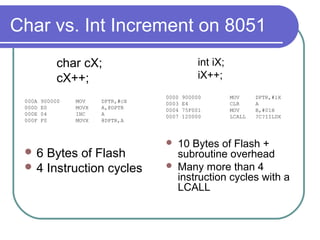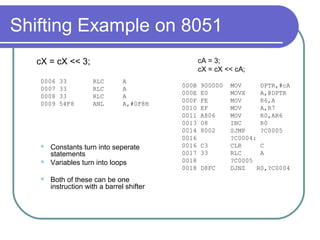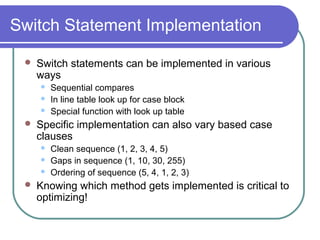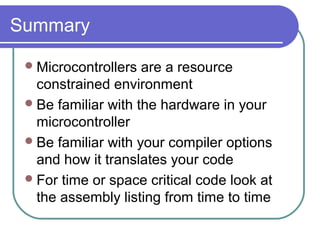C for Microcontrollers
- 1. ‘C’ for Microcontrollers, Just Being Efficient Lloyd Moore, President [email protected] www.CyberData-Robotics.com Seattle Robotics Society 9/15/2012
- 2. Agenda MicrocontrollerResources Knowing Your Environment Memory Usage Code Structure Optimization Summary
- 3. Disclaimer Some microcontroller techniques necessarily need to trade one benefit for another – typically lower resource usage for maintainability Point of this presentation is to point out various techniques that can be used as needed Use these suggestions when necessary Feel free to suggest better solutions as we go along
- 4. Microcontroller Resources EVERYTHING resides on one die inside one package: RAM, Flash, Processor, I/O Cost is a MAJOR design consideration Typical costs are $0.25 to $25 each (1000’s) RAM: 16 BYTES to 256K Bytes typical Flash/ROM: 384 BYTES to 1M Byte Clock Speed: 4MHz to 175MHz typical Much lower for battery saving modes (32KHz) Busis 8, 16, or 32 bits wide Have dedicated peripherals (MAC, Phys, etc)
- 5. Power Consumption Microcontrollers typically used in battery operated devices Power requirements can be EXTREMELY tight Energy harvesting applications Long term battery installations (remote controls, hard to reach devices, etc.) EVERY instruction executed consumes power, even if you have the time and memory!
- 6. Know Your Environment Traditionallywe ignore hardware details Need to tailor code to hardware available Specialized hardware MUCH more efficient Compilers typically have extensions Interrupt – specifies code as being ISR Memory model – may handle banked memory and/or simultaneous access banks Multiple data pointers / address generators Debugger may use some resources
- 7. Memory Usage Put constant data into program memory (Flash/ROM) Alignment / padding issues Typically NOT an issue, non-aligned access ok Avoid dynamic memory allocation, even if available Take extra space and processing time Memory fragmentation a big issue Use and reuse static buffers Reduces variable passing overhead Allows for smaller / faster code due to reduced indirections Does bring back over write bugs if not done carefully More reliable for mission critical systems Use the appropriate variable type Don’t use int and double for everything!! Affects processing time as well as storage
- 8. C99 Datatypes – inttypes.h int8_t,int16_t, int32_t, int64_t uint8_t, uint16_t, uint32_t, uint_64_t Avoids the ambiguity of int and uint when moving code between processors of different native size Makes code more portable and upgradable over time
- 9. Char vs. Int Increment on 8051 char cX; int iX; cX++; iX++; 0000 900000 MOV DPTR,#iX 000A 900000 MOV DPTR,#cX 0003 E4 CLR A 000D E0 MOVX A,@DPTR 0004 75F001 MOV B,#01H 000E 04 INC A 0007 120000 LCALL ?C?IILDX 000F F0 MOVX @DPTR,A 10 Bytes of Flash + 6 Bytes of Flash subroutine overhead 4 Instruction cycles Many more than 4 instruction cycles with a LCALL
- 10. Code Structure Count down instead of up Saves a subtraction on all processors Decrement-jump-not-zero style instruction on some processors Pointers vs. array notation Generally better using pointers Bit Shifting May not always generate what you think May or may not have barrel shifter hardware May or may not have logical vs. arithmetic shifts
- 11. Shifting Example on 8051 cX = cX << 3; cA = 3; cX = cX << cA; 0006 33 RLC A 000B 900000 MOV DPTR,#cA 0007 33 RLC A 000E E0 MOVX A,@DPTR 0008 33 RLC A 000F FE MOV R6,A 0009 54F8 ANL A,#0F8H 0010 EF MOV A,R7 0011 A806 MOV R0,AR6 0013 08 INC R0 0014 8002 SJMP ?C0005 0016 ?C0004: Constants turn into seperate 0016 C3 CLR C statements 0017 33 RLC A Variables turn into loops 0018 ?C0005 0018 D8FC DJNZ R0,?C0004 Both of these can be one instruction with a barrel shifter
- 12. Indexed Array vs Pointer on M8C ucMode = g_Channels[uc_Channel].ucMode; ucMode = pChannel->ucMode; 01DC 52FC mov A,[X-4] 01ED 5201 mov A,[X+1] 01DE 5300 mov [__r1],A 01EF 5300 mov [__r1],A 01E0 5000 mov A,0 01F1 3E00 mvi A,[__r1] 01E2 08 push A 01E3 5100 mov A,[__r1] 01F3 5405 mov [X+5],A 01E5 08 push A 01E6 5000 mov A,0 Does the same thing 01E8 08 push A Saves 29 bytes of memory AND a 01E9 5007 mov A,7 01EB 08 push A call to a 16 bit multiplication routine! 01EC 7C0000 xcall __mul16 Pointer version will be at least 4x 01EF 38FC add SP,-4 faster to execute as well, maybe 10x 01F1 5F0000 mov [__r1],[__rX] Most compilers not this bad – but you 01F4 5F0000 mov [__r0],[__rY] do find some! 01F7 060000 add[__r1],<_g_Channels 01FA 0E0000 adc[__r0],>_g_Channels 01FD 3E00 mvi A,[__r1] 01FF 5403 mov [X+3],A
- 13. More Code Structure Actual parameters typically passed in registers if available Keep function parameters to less than 3 May also be passed on stack or special parameter area May be more efficient to pass pointer to struct Global variables While generally frowned upon for most code can be very helpful here Typically ends up being a direct access Read assembly code for critical areas Know which optimizations are present Small compilers do not always have common optimizations Inline, loop unrolling, loop invariant, pointer conversion
- 14. Switch Statement Implementation Switch statements can be implemented in various ways Sequential compares In line table look up for case block Special function with look up table Specific implementation can also vary based case clauses Clean sequence (1, 2, 3, 4, 5) Gaps in sequence (1, 10, 30, 255) Ordering of sequence (5, 4, 1, 2, 3) Knowing which method gets implemented is critical to optimizing!
- 15. Switch Statement Example switch(cA) 0006 900000 MOV DPTR,#cA { 0009 E0 MOVX A,@DPTR 000A FF MOV R7,A case 0: 000B EF MOV A,R7 cX = 4; 000C 120000 LCALL ?C?CCASE break; 000F 0000 DW ?C0003 case 1: 0011 00 DB 00H cX = 10; 0012 0000 DW ?C0002 break; 0014 01 DB 01H case 2: 0015 0000 DW ?C0004 cX = 30; 0017 02 DB 02H break; 0018 0000 DW 00H default: 001A 0000 DW ?C0005 cX = 0; break; 001C ?C0002: } 001C 900000 MOV DPTR,#cX 001F 7404 MOV A,#04H 0021 F0 MOVX @DPTR,A 0022 8015 SJMP ?C0006 ...More blocks follow for each case
- 16. Optimization Process Step 0 – Before coding anything, think about risk points and prototype unknowns!!! Use available dedicated hardware Step 1 – Get it working!! Fast but wrong is of no use to anyone Optimization will typically reduce readability Step 2 – Profile to know where to optimize Usually only one or two routines are critical You need to have specific performance metrics to target
- 17. Optimization Process Step 3 – Let the tools do as much as they can Turn off debugging! Select the correct memory model Select the correct optimization level Step 4 – Do it manually Read the generated code! Might be able to make a simple code or structure change. Last – think about assembly coding
- 18. Summary Microcontrollers are a resource constrained environment Be familiar with the hardware in your microcontroller Be familiar with your compiler options and how it translates your code For time or space critical code look at the assembly listing from time to time
- 19. Questions?











![Indexed Array vs Pointer on M8C
ucMode = g_Channels[uc_Channel].ucMode; ucMode = pChannel->ucMode;
01DC 52FC mov A,[X-4] 01ED 5201 mov A,[X+1]
01DE 5300 mov [__r1],A 01EF 5300 mov [__r1],A
01E0 5000 mov A,0
01F1 3E00 mvi A,[__r1]
01E2 08 push A
01E3 5100 mov A,[__r1] 01F3 5405 mov [X+5],A
01E5 08 push A
01E6 5000 mov A,0 Does the same thing
01E8 08 push A Saves 29 bytes of memory AND a
01E9 5007 mov A,7
01EB 08 push A
call to a 16 bit multiplication routine!
01EC 7C0000 xcall __mul16 Pointer version will be at least 4x
01EF 38FC add SP,-4 faster to execute as well, maybe 10x
01F1 5F0000 mov [__r1],[__rX] Most compilers not this bad – but you
01F4 5F0000 mov [__r0],[__rY] do find some!
01F7 060000 add[__r1],<_g_Channels
01FA 0E0000 adc[__r0],>_g_Channels
01FD 3E00 mvi A,[__r1]
01FF 5403 mov [X+3],A](https://image.slidesharecdn.com/cformicrocontrollers-130401144933-phpapp02/85/C-for-Microcontrollers-12-320.jpg)






